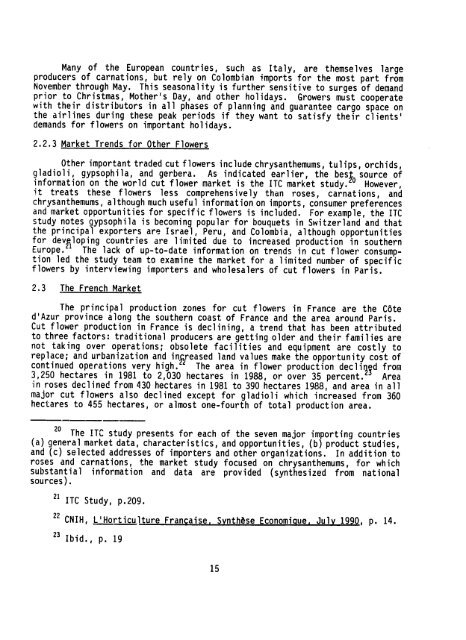APIP Agricultural Policy Implementation Project
APIP Agricultural Policy Implementation Project
APIP Agricultural Policy Implementation Project
Create successful ePaper yourself
Turn your PDF publications into a flip-book with our unique Google optimized e-Paper software.
Many of the European countries, such as Italy, are themselves large<br />
producers of carnations, but rely on Colombian imports for the most part from<br />
November through May. This seasonality is further sensitive to surges of demand<br />
prior to Christmas, Mother's Day, and other holidays. Growers must cooperate<br />
with their distributors in all phases of planning and guarantee cargo space on<br />
the airlines during these peak periods if they want to satisfy their clients'<br />
demands for flowers on important holidays.<br />
2.2.3 Market Trends for Other Flowers<br />
Other important traded cut flowers include chrysanthemums, tulips, orchids,<br />
gladioli, gypsophila, and gerbera. As indicated earlier, the besh source of<br />
information on the world cut flower market is the ITC market study. However,<br />
it treats these flowers less comprehensively than roses, carnations, and<br />
chrysanthemums, although much useful information on imports, consumer preferences<br />
and market opportunities for specific flowers is included. For example, the ITC<br />
study notes gypsophila is becoming popular for bouquets in Switzerland and that<br />
the principal exporters are Israel, Peru, and Colombia, although opportunities<br />
for developing countries are limited due to increased production in southern<br />
Europe. The lack of up-to-date information on trends in cut flower consumption<br />
led the study team to examine the market for a limited number of specific<br />
flowers by interviewing importers and wholesalers of cut flowers in Paris.<br />
2.3 The French Market<br />
The principal production zones for cut flowers in France are the Cbte<br />
d'Azur province along the southern coast of France and the area around Paris.<br />
Cut flower production in France is declining, a trend that has been attributed<br />
to three factors: traditional producers are getting older and their families are<br />
not taking over operations; obsolete facilities and equipment are costly to<br />
replace; and urbanization and increased land values make the opportunity cost of<br />
continued operations very high." The area in flower production declined from<br />
3,250 hectares in 1981 to 2,030 hectares in 1988, or over 35 percent." Area<br />
in roses declined from 430 hectares in 1981 to 390 hectares 1988, and area in all<br />
major cut flowers also declined except for gladioli which increased from 360<br />
hectares to 455 hectares, or almost one-fourth of total production area.<br />
20 The ITC study presents for each of the seven major importing countries<br />
(a)general market data, characteristics, and opportunities, (b)product studies,<br />
and (c)selected addresses of importers and other organizations. In addition to<br />
roses and carnations, the market study focused on chrysanthemums, for which<br />
substantial information and data are provided (synthesized from national<br />
sources).<br />
21 ITC Study, p.209.<br />
22 CNIH, L'Horticulture Francaise, Synthbse Economique, July 1990, p. 14.<br />
23 Ibid., p. 19<br />
15

















